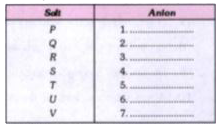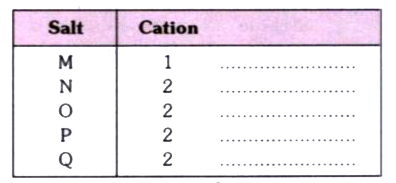Statement-1 :White precipitate of Mg(OH)2 is insoluble in excess of sodium hydroxide but readily soluble in solution of ammonium salts.
Statement-2 :Mg(OH)2 is very sparingly soluble in water.
STATEMENT-1 is true, STATEMENT-2 is true and STATEMENT-2 is correct explanation for STATEMENT-1
STATEMENT-1 is true, STATEMENT-2 is true and STATEMENT-2 is not correct explanation for STATEMENT-2
STATEMENT-1 is true, STATEMENT-2 is false
STATEMENT-1 is false, STATEMENT-2 is true
The correct Answer is:B
To analyze the statements regarding magnesium hydroxide, we will evaluate each statement step by step.
Step 1: Evaluate Statement 1
Statement 1: "White precipitate of Mg(OH)₂ is insoluble in excess of sodium hydroxide but readily soluble in a solution of ammonium salts."
- Explanation: Magnesium hydroxide (Mg(OH)₂) is a white precipitate that is known to be insoluble in water. When it is added to a solution of sodium hydroxide (NaOH), the concentration of hydroxide ions (OH⁻) increases. According to Le Chatelier's principle, this increase in OH⁻ ions causes the equilibrium to shift to the left, reducing the solubility of Mg(OH)₂. Therefore, Mg(OH)₂ remains insoluble in excess NaOH.
- Ammonium Salts: When Mg(OH)₂ is treated with ammonium salts (like NH₄Cl), the NH₄⁺ ions react with OH⁻ ions to form NH₄OH (ammonium hydroxide). This reaction decreases the concentration of OH⁻ ions in the solution, which shifts the equilibrium to the right, increasing the solubility of Mg(OH)₂. Thus, Mg(OH)₂ is readily soluble in solutions of ammonium salts.
Conclusion for Statement 1: This statement is correct.
Step 2: Evaluate Statement 2
Statement 2: "Mg(OH)₂ is very sparingly soluble in water."
- Explanation: The solubility product (Ksp) of magnesium hydroxide is approximately 1.0 × 10⁻¹², indicating that it is indeed very sparingly soluble in water. This low Ksp value confirms that only a minimal amount of Mg(OH)₂ can dissolve in water, leading to its classification as sparingly soluble.
Conclusion for Statement 2: This statement is also correct.
Step 3: Determine the Relationship Between the Statements
- Explanation of Relationship: While both statements are correct, Statement 2 does not serve as an explanation for Statement 1. Statement 1 discusses the behavior of Mg(OH)₂ in different environments (NaOH vs. ammonium salts), while Statement 2 simply states its solubility in water without explaining the behavior in the context of sodium hydroxide or ammonium salts.
Final Conclusion
- Statement 1 is correct.
- Statement 2 is correct.
- Statement 2 is not a correct explanation of Statement 1.
Statement 1: "White precipitate of Mg(OH)₂ is insoluble in excess of sodium hydroxide but readily soluble in a solution of ammonium salts."
Statement 2: "Mg(OH)₂ is very sparingly soluble in water."
- Explanation of Relationship: While both statements are correct, Statement 2 does not serve as an explanation for Statement 1. Statement 1 discusses the behavior of Mg(OH)₂ in different environments (NaOH vs. ammonium salts), while Statement 2 simply states its solubility in water without explaining the behavior in the context of sodium hydroxide or ammonium salts.
- Statement 1 is correct.
- Statement 2 is correct.
- Statement 2 is not a correct explanation of Statement 1.
Similar Questions
Which of the following statements is/ are correct ?
(I) White precipitate of Zn(OH)2 is soluble in excess ammonia
and in solutions of ammonium salts.
(II) Yellow precipitate of barium chromate is soluble in dilute
acetic acid as well as in mineral acids.
(III) Green precipitate of Ni(OH)2 is soluble in excess sodium hydroxide.View SolutionPartial precipitation of Mn2+ as Mn(OH)2 occurs with ammonia solution but the precipitate is soluble in ammonium salts. Explain?
View SolutionSalts P, Q,R,S,T,U and V undergo reactions (i) to (vii) respectively. Identify the cation present in these salts on the basis of these reactions. Tabulate your answer in the formate given below.
(i) When the salt Pis heated with sodium hydroxide solution a vigorous reaction takes place and a colourless gas is evolved with a pungent and suffocating smell that brings tears in our eyes. The evolved gas gives dense white fumes with a moist glass rod depped with hydrochloric acid.
(ii) Addition of sodium hydroxide solution to a solution of salt Q gives a thick white precipitae which is soluble in excess of sodium hydroxide solution to form a clear solution.
(iii) Addition of ammonium hydroxide solution to a solution of salt R gives a dark blue precipitate which is soluble is excess of ammonium hydroxide solution to form an intense deep blue solution.
(iv) Addition of ammonium hydroxide solution to a solution of 5 gives a dirty green [bottle green] precipitate which is insoluble even in the excess of ammonium hydroxide solution.
(v) Addition of ammonium hydroxide solution to a solution of T gives a reddish brown (rust precipitate] precipitate which is insoluble even in the excess of ammonium hydroxide solution.
(vi) Addition of ammonium hydroxide solution to a solution of V gives a geletaneous white precipitate which is soluble in excess of ammonium hydroxide solution to form a clear solution.
(vii) Addition of ammonium hydroxide solution to a solution of V gives no precipitate but it gives a chalky white precipitate with sodium hydroxide solution which is insoluble even in the excess of sodium hydroxide solution.
 View Solution
View SolutionStatement-1:White precipitate of zinc phosphate is soluble in Ammonia.
Statement-2:Zinc phosphate forms a soluble complex with ammonia.View SolutionThe hydroxides and carbonates of sodium and potassium are easily soluble in water while the corresponding salts of magnesium and calcium are sparingly soluble in water. Explain.
View SolutionExplain giving reasons why:
(i) Mg(OH)2 is sparingly soluble in water but highly soluble in ammonium chloride solution.View SolutionSalts M, N, O, P and Q undergo reactiom (i) to (v) respectively.
Identify the cation present in these salts on the basis of these reaction. Tabulate your answer in the format given below.
1. When sodium hydroxide solution is added to the salt M, and heated strongly a colourless gas with a pungent smell is evolved which turm red litmus paper blue and gives dense white fumes with a moist glass rod with hydrochloric acid.
2. Addition of dilute hydrochloric acid to a solution of N gives a thick white precipitate which is soluble in hot water.
3. When ammonium hydroxide solution is added to the solution of 0 a light blue precipitate is obtained which is soluble in excess of ammonium hydroxide to form an inteme deep blue solution.
4. When ammonium hydroxide solution is added to the solution of P reddish brown (mustard colour) precipitate is obtained which ,is insoluble even in the excess of ammonium hydroxide solution.
5. When sodium hydroxide solution is added to the solution of Q a which coloured gelatinous precipitate is obtained which is soluble in excess of sodium hydroxide to form a clear solution
 View Solution
View SolutionIdentify the cation (positive ion) and anion (negative ion) in - 'A','B' & 'C'. Also identify P, Q, R, S, T, U, V, W.
a] Substance 'A' is water soluble and gives a curdy white precipitate 'P' with silver nitrate solution. 'P' is soluble in ammonium hydroxide but insoluble in dil. HNO3 . Substance 'A' reacts with ammonium hydroxide solution to give a white precipitate ' soluble in excess of NH4OH.
b] A solution of substance 'B' is added to barium chloride solution. A white ppt. 'R' is formed, insoluble in dil. HCl or HNO3 . A dirty green ppt. 'S' is formed on addition of ammonium hydroxide to a solution of 'B' and the precipitate is insoluble in excess of ammonium hydroxide.
c] Substance 'C' is a coloured, crystalline salt which on heating decomposes leaving a black residue 'T'. On addition of copper turnings and conc. H2SO4 to 'C' a coloured acidic gas 'U' is evolved on heating. A solution of'C' is added to NaOH soln. until in excess. A pale blue ppt. 'P' is obtained insoluble in excess of NaOH A solution of 'C' is then added to NH4OH soln. in excess to give an inky blue solution 'V'. A solution of 'C' is warmed and hydrogen sulphide gas is passed through it. A black ppt. 'W' appears.View SolutionStatement-1: Hydroxides of group-2 are less soluble in water than hydroxides of group-1.
Statement-2: CaF2 is least soluble in among other fluoride of group-2.
Statement-3: Li gives red coloured flame.View SolutionBurning magnesium ribbon is taken in gas P when it form a salt R. The salt R dissolves in water and gives curdy white precipitate with silver nitrate solution. This precipitate is soluble in excess of ammonium hydroxide solution. Name the gas P and salt R. State the chemical reaction between P and magnesium
View Solution

